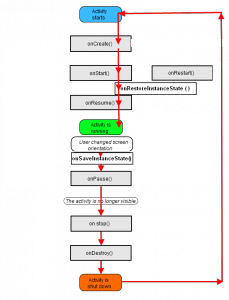R.string to string R.array to array Android
R.string to string Android source code
R.array to string [] Android source code
R.array to string [] Android source code
String s = getResources().getString(R.string.my_string); // Hello world!!
String[] arrayOfStrings = getResources().getStringArray(R.array.my_array); // one, two
<xml version="1.0" encoding="utf-8">
<resources>
<string-array name="my_array">
<item>one</item>
<item>two</item>
</string-array>
<string name="my_string">Hello world!!</string>
</resources>
396LW NO topic_id
AD
Další témata ....(Topics)
onSaveInstanceState, onRestoreInstanceState life cycle if screen orientation changed from log file.
Diagram of life cycle onSaveInstanceState, onRestoreInstanceState
[caption id="attachment_1169" align="alignleft" width="229" caption="Life cycle onRestoreInstanceState"] [/caption]
[/caption]
// starts activity
15:27:12.801: INFO/onCreate(1828): onCreate()
15:27:12.811: INFO/onStart(1828): onStart()
15:27:12.821: INFO/onResume(1828): onResume()
// activity is running
15:27:33.651: DEBUG/dalvikvm(307): GC_EXPLICIT freed 186K, 53%
free 2770K/5831K, external 981K/1038K, paused 99ms
// change emulator state Ctrl+F11 landscape, portrait
15:27:40.427: INFO/ActivityManager(74): Config changed:
{ scale=1.0 imsi=310/260 loc=en_US touch=3 keys=2/1/2 nav=3/1 orien=2 layout=18 uiMode=17 seq=64}
// saved all variable values if need
15:27:40.581: INFO/onSaveInstanceState(1828): onSaveInstanceState()
15:27:40.602: INFO/onPause(1828): onPause()
15:27:40.612: INFO/onStop(1828): onStop()
15:27:40.631: INFO/onDestroy(1828): onDestroy()
// activity goes back to onCreate !!!!!!!!!
15:27:40.692: INFO/onCreate(1828): onCreate()
15:27:40.701: INFO/onStart(1828): onStart()
// restore all saved values of variables
15:27:40.711: INFO/onRestoreInstanceState(1828): onRestoreInstanceState()
// you can using saved values by onSaveInstanceState() in onResume
15:27:40.721: INFO/onResume(1828): onResume()
Diagram of life cycle onSaveInstanceState, onRestoreInstanceState
[caption id="attachment_1169" align="alignleft" width="229" caption="Life cycle onRestoreInstanceState"]
 [/caption]
[/caption]Difference between "@+id/” and "@id/” in Android
android:id="@+id/xxx" unique identifier of view
@id/ a reference to the unique identifier
android:id="@+id/xxx" unique identifier of view
@id/ a reference to the unique identifier
<TextView
android:id="@+id/first_element_id"
.........
/>
<TextView
android:id="@+id/second_element_id"
android:layout_below="@id/first_element_id"
..........
/>
Samsung S6102 Galaxy Y Duos umožňuje pracovat se dvěma aktivními SIM kartami a má GPS navigaci. Cena cca 4.500 korun / léto 2012.
Displej
Rozlišení displeje 320 x 240
Velikost displeje 3.14 "
Počet barev 262000
Rozměry 104 mm x 60 mm x 11.5 mm
Fotoaparát 3 Mpix, natačení videosekvencí
Operační system Android 2.3 (Gingerbread)
Procesor 832 MHz
Funkce Dual sim, Změny velikosti písma, Java, Internetový prohlížeč Přehrávání MP3, jack 3,5, Psaní SMS a e-mailů Multimediální zprávy MMS, Dlouhé SMS, Emailový prohlížeč, Kontakty a volání Hlasité handsfree, MP3/WMA/AAC vyzvánění, Skupiny volajících, Baterie
Typ baterie Li-Ion 1300 mAh
Doba hovoru 370 min
Pohotovostní doba 440 hodin
Uživatelská paměť 160 MB
Datové funkce GPS modul, WiFi, Bluetooth, GPRS, EDGE, Hardwarový modem
Aplikace Diktafon, Kalendář, FM rádio, Záznamník hovoru, Hry v telefonu, Kalkulačka, Budík
Mobilní telefony Samsung mají velmi dobrý poměr KVALITA / CENA

Displej
Rozlišení displeje 320 x 240
Velikost displeje 3.14 "
Počet barev 262000
Rozměry 104 mm x 60 mm x 11.5 mm
Fotoaparát 3 Mpix, natačení videosekvencí
Operační system Android 2.3 (Gingerbread)
Procesor 832 MHz
Funkce Dual sim, Změny velikosti písma, Java, Internetový prohlížeč Přehrávání MP3, jack 3,5, Psaní SMS a e-mailů Multimediální zprávy MMS, Dlouhé SMS, Emailový prohlížeč, Kontakty a volání Hlasité handsfree, MP3/WMA/AAC vyzvánění, Skupiny volajících, Baterie
Typ baterie Li-Ion 1300 mAh
Doba hovoru 370 min
Pohotovostní doba 440 hodin
Uživatelská paměť 160 MB
Datové funkce GPS modul, WiFi, Bluetooth, GPRS, EDGE, Hardwarový modem
Aplikace Diktafon, Kalendář, FM rádio, Záznamník hovoru, Hry v telefonu, Kalkulačka, Budík
Mobilní telefony Samsung mají velmi dobrý poměr KVALITA / CENA

- create new folder with values in resources folder in project with extension your language code
For example:
My language is Czech (cs)
I have to create the folder values-cs in res folder
Into every values folder put strings.xml file
Translate every string from values folder into your locale.
If user selected your locale in device settings, application selects a string from the correct (proper) folder.
For example:
My language is Czech (cs)
I have to create the folder values-cs in res folder
// for locale English is default
/MyProject/res/values
<?xml version="1.0" encoding="utf-8"?>
<resources>
<string name="app_name">App English default</string>
<string name="action_settings">Settings English default</string>
<string name="hello_world">Hello world</string>
</resources>
// for locale Czech (cs)
/MyProject/res/values-cs
<?xml version="1.0" encoding="utf-8"?>
<resources>
<string name="app_name">Aplikace česky cs</string>
<string name="action_settings">Nastavení česky</string>
<string name="hello_world">Ahoj světe!</string>
</resources>
// for locale English US (r is region)
/MyProject/res/values-en-rUS
<?xml version="1.0" encoding="utf-8"?>
<resources>
<string name="app_name">App English Us locale</string>
<string name="action_settings">Settings English Us locale</string>
<string name="hello_world">Hello world from USA :)</string>
</resources>
Into every values folder put strings.xml file
Translate every string from values folder into your locale.
If user selected your locale in device settings, application selects a string from the correct (proper) folder.
Button, setOnClickListener, Intent.ACTION_VIEW, startActivity Android example.
Button mIdButtonHome = (Button)findViewById(R.id.idButtonHome);
mIdButtonHome.setOnClickListener(new View.OnClickListener() {
public void onClick(View v) {
Intent browserIntent = new Intent(
Intent.ACTION_VIEW,
Uri.parse("//android.okhelp.cz/category/software/"));
startActivity(browserIntent);
}
});
Editace: 2013-12-09 11:03:12
Počet článků v kategorii: 396
Url:r-string-to-string-r-array-to-array-android



